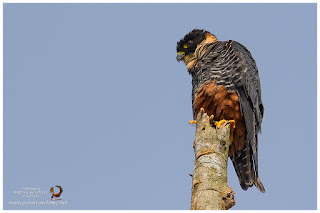In this post we continue our coverage of the Pipeline Road; the place selected as Panama Birds & Wildlife Photos' Best Place of 2015. Now we travel out of the forest to the surrounding areas of this world famous road. Mainly to the also famous Ammo Dump Pond, a small marsh en-route to Pipeline Road. Its name was given by the USA Army when they controlled the area, allegedly because the wetland was close to the place in which they used to store ammo (short for ammunition). Is of our understanding that currently, the Panama Canal Authority stores explosives there but don't worry, the storage area is not really close to the birding area, and access to the Canal facilities are restricted.
We also traveled on several occasions to Summit Ponds, a name given by Americans too, which is located on a remaining patch of what used to be the Old Road to Gamboa, close to Summit Park, and finally to Calamito Lake located inside the concession area of Panama Rainforest Discovery Center. Both great birding areas on their own, were we have made tons of pictures before. Disregarding that fact, most of the pictures below were made in Ammo Dump Pond.
Bat Falcon (Falco rufigularis). We observed a couple, which we presume were mating, over several weeks perched high on a dead tree close to the Ammo Dump Pond. We did our best effort to get this picture of one of them. Unfortunately the angle was not that good. This small dark
bird of prey is a resident in tropical Mexico, Central and South America and Trinidad. It inhabits open woodlands and
forest clearings, and
perch conspicuously on high open snags, from which they launch aerial attacks on their prey. They hunt bats, birds and large insects such as dragonflies. The smaller male takes more insects, and the female more birds and bats. The flight is direct and powerful. This falcon is partly
crepuscular, as the bats in its diet suggest. In Panama it's
uncommon and found
countrywide in rivers and edge of forest,
semi open areas, from
lowlands to middle elevations.

Green Kingfisher (Chloroceryle americana) females have buff-white underparts with two green chest bands, the lower of which links to the green spotting along the sides of the belly.
Pied-billed Grebe (Podilymbus podiceps)
Plain-colored Tanager (Tangara inornata) is unusual among the colourful congeneric Tangaras. It is a plain grey bird with dark wings and tail, and a blue shoulder patch that is usually hidden when the bird is perched.
Tropical Kingbird (Tyrannus melancholicus)
Purple Gallinule (Porphyrio martinicus) is a "swamp hen" in the
rail family, Rallidae. Other rails (White-throated Crake and Sora) can be seen or heard at the Ammo Dump Pond too but vegetation difficults getting good pictures. Gallinules tend to be more conspicuos and often perch as this moulting individual.
Rufescent Tiger Heron (Tigrisoma lineatum) - juvenile
Rufescent Tiger Heron (Tigrisoma lineatum) - adult
The jackpot of these photographic trips was a "family" of Rufescent Tiger Herons (Tigrisoma lineatum). On one occasion we observed three individuals. The first that caught our attention was a juvenile perched low in the closest edge of the pond. In our experience young ones tend to be less shy and more conspicuos than adults. The other two were adults, one perched high in a tree on the far edge of the marsh (not pictured), and another one foraging in the marsh. We waited as much as we could expecting to get a shot catching a prey (fish, frog, snake, etc) but it never happened.
The genus name Tigrisoma is a combination of two Greek words: tigris, meaning "tiger" and soma, meaning "body". This is one of the three species of Tiger Herons, all occurring in Panama. The adult is relatively easy to distinguish from fasciated and bare-throated tiger herons, as it is rufous (rather than primarily gray) on the head and neck. Young birds, however, are much more difficult to identify.
The adult's head, neck and chest are dark rufous, with a white stripe down the center of the foreneck. The remainder of its upperparts are brownish with fine black vermiculation. The juvenile bird is rusty-buff overall, coarsely barred with black; the buff and black banding on its wings is especially pronounced. It takes five years to acquire adult plumage.
In Panama the rufescent tiger heron is common in wet pastures, marshes, swampy forest,
edges of ponds in
lowlands on entire
Caribbean slope and eastern Pacific slope.
To be continued...













Comments
Post a Comment